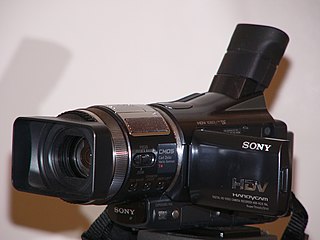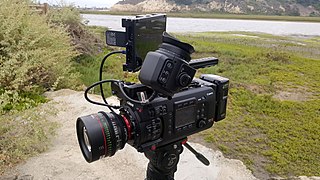
MPEG-2 is a standard for "the generic coding of moving pictures and associated audio information". It describes a combination of lossy video compression and lossy audio data compression methods, which permit storage and transmission of movies using currently available storage media and transmission bandwidth. While MPEG-2 is not as efficient as newer standards such as H.264/AVC and H.265/HEVC, backwards compatibility with existing hardware and software means it is still widely used, for example in over-the-air digital television broadcasting and in the DVD-Video standard.

Standard-definition television is a television system that uses a resolution that is not considered to be either high or enhanced definition. Standard refers to offering a similar resolution to the analog broadcast systems used when it was introduced.

DV is a family of codecs and tape formats used for storing digital video, launched in 1995 by a consortium of video camera manufacturers led by Sony and Panasonic. It includes the recording or cassette formats DV, MiniDV, DVCAM, Digital8, HDV, DVCPro, DVCPro50 and DVCProHD. DV has been used primarily for video recording with camcorders in the amateur and professional sectors.

Telecine is the process of transferring film into video and is performed in a color suite. The term is also used to refer to the equipment used in this post-production process.
In video technology, 24p refers to a video format that operates at 24 frames per second frame rate with progressive scanning. Originally, 24p was used in the non-linear editing of film-originated material. Today, 24p formats are being increasingly used for aesthetic reasons in image acquisition, delivering film-like motion characteristics. Some vendors advertise 24p products as a cheaper alternative to film acquisition.

HDV is a format for recording of high-definition video on DV videocassette tape. The format was originally developed by JVC and supported by Sony, Canon, and Sharp. The four companies formed the HDV Consortium in September 2003.
Film look is a process in which video is altered in overall appearance to appear to have been shot on film stock. The process is usually electronic, although filmizing can sometimes occur as an unintentional by-product of some optical techniques, such as telerecording. The effect is the exact opposite of a process called VidFIRE.
480p is the shorthand name for a family of video display resolutions. The p stands for progressive scan, i.e. non-interlaced. The 480 denotes a vertical resolution of 480 pixels, usually with a horizontal resolution of 640 pixels and 4:3 aspect ratio or a horizontal resolution of 854 pixels for an approximate 16:9 aspect ratio. Since a pixel count must be a whole number, in Wide VGA displays it is generally rounded up to 854 to ensure inclusion of the entire image. The frames are displayed progressively as opposed to interlaced. 480p was used for many early plasma televisions. Standard definition has always been a 4:3 aspect ratio with a pixel resolution of 720 × 480 at 60 Hz for NTSC regions, and 720 or 768 × 576 for PAL regions. However, standard definition defines a 15.7k Hz horizontal scanrate, which means that interlacing has to be used for those resolution modes. The lowercase letter "p" in 480p stands for progressive, so the two must not be confused.

720p is a progressive HD signal format with 720 horizontal lines/1280 columns and an aspect ratio (AR) of 16:9, normally known as widescreen HD (1.78:1). All major HD broadcasting standards include a 720p format, which has a resolution of 1280×720p.

576i is a standard-definition digital video mode, originally used for digitizing analogue television in most countries of the world where the utility frequency for electric power distribution is 50 Hz. Because of its close association with the legacy colour encoding systems, it is often referred to as PAL, PAL/SECAM or SECAM when compared to its 60 Hz NTSC-colour-encoded counterpart, 480i.
High-definition video is video of higher resolution and quality than standard-definition. While there is no standardized meaning for high-definition, generally any video image with considerably more than 480 vertical scan lines or 576 vertical lines (Europe) is considered high-definition. 480 scan lines is generally the minimum even though the majority of systems greatly exceed that. Images of standard resolution captured at rates faster than normal, by a high-speed camera may be considered high-definition in some contexts. Some television series shot on high-definition video are made to look as if they have been shot on film, a technique which is often known as filmizing.
Progressive segmented Frame is a scheme designed to acquire, store, modify, and distribute progressive scan video using interlaced equipment.

The Sony HDR-HC1, introduced in mid-2005, is the first consumer HDV camcorder to support 1080i.

A digital movie camera for digital cinematography is a video camera that captures footage digitally rather than the historically used movie camera, which shoots on film stock. Different digital movie cameras output a variety of different acquisition formats. Cameras designed for domestic use have also been used for low-budget independent productions.

The Panasonic Lumix DMC-GH1 is a digital mirrorless interchangeable lens camera adhering to the Olympus and Panasonic developed Micro Four Thirds System (MFT) system design standard. Panasonic classified the GH1 as a hybrid stills/video camera and the GH1 was introduced and marketed as a higher end camera than Panasonic's first MFT camera, the stills only, non-video capable Lumix DMC-G1.
The aspect ratio of an image is the ratio of its width to its height. It is expressed as two numbers separated by a colon, width:height. Common aspect ratios are 1.85:1 and 2.40:1 in cinematography, 4:3 and 16:9 in television, and 3:2 in still photography.

The Panasonic Lumix DMC-GH2 is a digital camera with HD video recording capability that is part of the Micro Four Thirds system. Though commonly referred to as a DSLR camera, it has no mirror or optical viewfinder, but has instead both a fold-out LCD screen and a electronic viewfinder.










